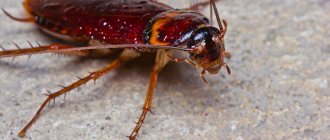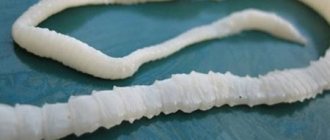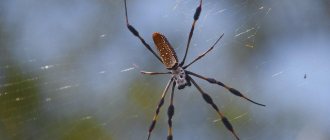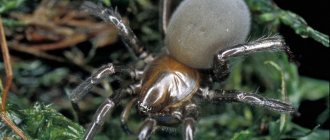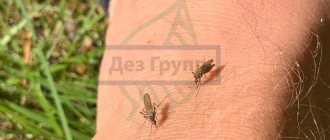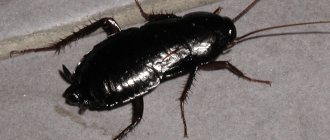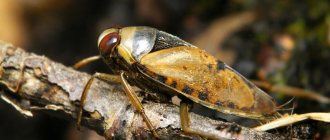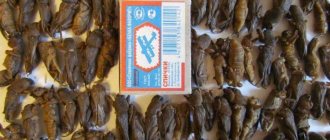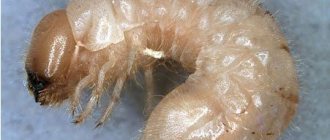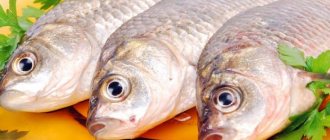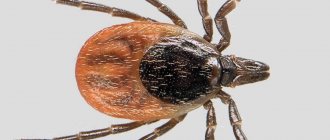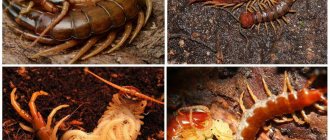The sea cockroach or sea cockroach (Saduria entomon) is a species of benthic arthropod that belongs to the family Chaetiliidae. Outwardly, this creature evokes only a negative attitude, because it resembles a cockroach, while it has nothing in common with ordinary cockroaches that we encountered in homes, shops and public catering establishments. Let's look at the features of this creature and learn about its rich history.
Sea cockroach, appearance
Description
Latin name Saduria entomon. Belongs to the class of higher crayfish, order of isopods.
The water cockroach is often called a trilobite. But, if you look at the photo of a sea cockroach, it becomes clear that it looks almost like a land woodlouse. And this coincidence is not accidental. Woodlice also belongs to crustaceans from the order Isopods. These relatives differ in their rear part: the water cockroach has an elongated and pointed tail.
The size of the underwater cockroach is small: no more than 9 cm. In the Baltic Sea, the largest specimens are found at the bottom of the Gulf of Bothnia.
Interesting!
The largest sea cockroaches found by people were 10 cm long.
Although these isopods are not gigantic in size, they are officially recognized as the largest crustaceans of the Baltic Sea. Males are usually larger than females.
The color of isopods can be:
- gray;
- sandy;
- light brown;
- beige.
The color of a sea animal depends on the color of the bottom on which it lives and is of a camouflage nature.
Features of the life of a sea cockroach
The sea cockroach lives along the coast at a depth of approximately 290 m. Most of its life it lives at the bottom of the reservoir; its favorite types of soil are sand, clay, gravel and mud. The sea cockroach swims quite poorly.
Its diet is varied: this crustacean can feed on plant debris, carrion, and even relatives, but it is also a predator. The sea cockroach preys on small organisms living on the bottom, for example, worm-like arthropods and small mollusks.
Reproduction in sea cockroaches occurs sexually; they are heterosexual creatures. The male fertilizes the female, after which she lays eggs in the ground. When the supply of nutrients is depleted, a larva emerges from the egg, and the first stage of development begins - nauplius.
The body of a sea cockroach larva consists of only two segments. She is quite vulnerable, because her chitinous cover has not yet hardened. As the crustacean grows, new segments form on the side of the tail.
Then comes the next stage of development of the sea cockroach - metanauplius. At this stage, the body of the larva has several segments, and the chitinous cover is already stronger. At this time, molting occurs, as a result of which the shell changes to a new, larger one. At this stage, internal changes of the sea cockroach also occur.
Body structure
The body shape is a long drop. The aquatic cockroach is covered with a shell, in addition to protection, which serves as an exoskeleton. The body is divided into 8 segments:
- cephalothorax;
- 6 back segments;
- the tail is the longest segment.
The arthropod's paws are attached to the four dorsal segments.
The head of a higher crustacean is protected from the front and sides by pointed plates. Between the plates there are eyes and short whiskers. Below are the gills.
The dorsal segments below also end in pointed plates with spines. Such high-quality protection allowed the animal to live unchanged since the last Ice Age, and perhaps longer.
Natural enemies of cuttlefish
Photo: Octopus cuttlefish
Due to the relatively small size of cuttlefish, they are preyed upon by numerous marine predators.
The main predators of cuttlefish are usually:
- shark;
- angler;
- swordfish;
- other cuttlefish.
Dolphins also attack these cephalopods, but feed only on their heads. Humans pose a threat to cuttlefish by hunting them. Their first form of defense is likely to be to evade detection by predators using their remarkable camouflage, which can make them look like coral, rocks or the seabed in the blink of an eye. Like its brother the squid, the cuttlefish can splash ink into the water, enveloping its would-be predator in a disorienting cloud of dirty blackness.
Researchers have long known that cuttlefish can respond to light and other stimuli while they are still developing inside the egg. Even before hatching, embryos are able to perceive a threat and change their breathing rate in response. The unborn cephalopod does everything it can in the womb to avoid detection when threatened by an approaching predator—including holding its breath. Not only is this behavior pretty incredible, it's also the first evidence that invertebrates can learn in the womb, just like humans and other vertebrates.
Lifestyle
The sea cockroach is a predatory animal that feeds on amphipods, small shrimp and mollusks. The basis of the arthropod’s diet is the crustacean Monoporeia affinis.
But very soon the predator may face the problem of hunger. Monoporeia affinis is sensitive to the oxygen content in water. Due to decreased oxygen levels in the Baltic Sea, and especially in the Gulf of Finland, the population of Monoporeia affinis began to decline.
Interesting!
Saduria entomon can also feed on rotting plant remains and carcasses of animals and fish.
Where does the sea cockroach live?
As already mentioned, the sea cockroach was able to survive the Ice Age; it is not afraid of the cold; it prefers to live in cold waters. Its main habitats are the coastal zone of the Baltic Sea, the Arctic Ocean and the North Pacific Ocean.
This crustacean can also be found in fresh water, in particular in the waters of European lakes: Venern, Vättern and Ladoga.
The sea cockroach is also an invasive species of the Black Sea, first noticed in 2009.
Categories
- Rest on the waters (119)
- Aqua style (75)
- Wind of wanderings (79)
- Water treatments (31)
- Questions - Answers (44)
- Guide (76)
- Living water (134)
- Animals (104)
- Nature reserves (127)
- Health (108)
- Consultation (66)
- Seas and oceans (235)
- Thinking out loud (57)
- National Park (91)
- Need to know (290)
- News (67)
- Image of water (52)
- Lakes and Rivers (99)
- Technology Parade (97)
- Drinking water (62)
- Planet Earth (172)
- Let's talk heart to heart (176)
- Journey into history (60)
- Plants (158)
- Republic (142)
- Let's solve the problem together (100)
- Pisces (64)
- Garden (159)
- Properties of water (39)
- Wells and wells (59)
- Events (66)
- Tourism (185)
- Interests and hobbies (44)
- Physical Geography (113)
- Photo album (183)
- Flowers and blossoms (124)
Species found in Russia
Scientists know more than 4.6 thousand species of cockroaches, but most of them live in warm countries. There are about 55 species of these insects in Russia, but only a few of them are the most popular.
Red cockroach (Blattella germanica)
People often call such parasites Prussians. They very often settle in residential areas and create huge colonies. Red cockroaches live in cabinets, drawers, furniture and even in the refrigerator. They feed on foods of any freshness and adapt to any conditions.
This is what attracts them to apartments and houses where people live:
- easily accessible food (on the table, floor, stove, in the trash can, etc.);
- plants that parasites can feed on in the absence of food;
- water is freely available (leaking pipes, remaining water in the sink, etc.).
Black beetle
People encounter not only Prussians, but also black cockroaches, which often live in human homes. Their colonies come from sewers, garbage cans and basements. It is known that parasites of this species rarely rise high, so they can only be found on the lower floors of residential buildings.
Here are the features of these insects:
- some individuals reach a length of 3 centimeters;
- the color can be not only black, but also dark brown and even red;
- they eat all types of foods, and if there is a shortage of them, they eat leftovers;
- reproduce noticeably faster than red cockroaches;
- They leave a specific and very unpleasant odor in their habitat.
IMPORTANT! These parasites live near a food source: under the refrigerator, behind the stove, near the trash can, etc.
It is believed that the presence of black cockroaches indicates a very poor sanitary situation.
This opinion was formed due to the fact that these insects carry dangerous diseases (cholera, E. coli, etc.). They move through sewers and street garbage cans, and then crawl into human housing, bringing with them a huge amount of bacteria and other harmful microorganisms.
In warm countries, black cockroaches do not live indoors. They settle only on the street, crawling under large stones or into cracks in buildings. Parasites enter residential buildings only in Russia. This is most likely due to the cold winter climate. Representatives of this species must be disposed of.
Fight with American guests
Thoughts about fighting large cockroaches arise in people the moment their presence is detected. The owner of the apartment is able to eliminate pests, provided that their numbers are small.
Housewives use proven methods to eliminate insect populations.
- Cold. If the temperature drops below those conditions that are acceptable for the development of the American cockroach, then the individual dies. To do this, open all the windows in the house in winter to reduce the temperature as much as possible. But you should use this method carefully. Indeed, due to low temperatures, the heating system may fail.
- Glue trap. Traps for cockroaches are sold in specialized stores. They are easy to make yourself. It is beneficial to use this cockroach repellent if there are only a small number of insects in the room.
- Chemicals. In specialized stores you can purchase an aerosol or gel against cockroaches. The use of contact pesticides, which quickly spread to areas where pests are concentrated, is also allowed.
- Folk remedies. To get rid of the flying americana cockroach in an apartment, you need to use boric acid or borax. Vegetable oil, potatoes or egg yolk are added to these substances. Balls are prepared from the resulting mixture and distributed throughout the room.
- Potent substances. This remedy is most effective in the fight against cockroaches. But it contains components that are unsafe for people and pets.
To choose an effective way to get rid of pests, it is necessary to take into account the number of individuals in the colony. If insects have filled all the rooms, then it is better to involve specialists.
Is it possible to eat them?
Interesting information for many gourmets will be that the sea cockroach is edible. It tastes a lot like shrimp or crayfish. Its meat is an excellent source of protein and essential microelements.
The only point that may repel potential connoisseurs of exquisite taste is the appearance of such a snack. However, if many peoples of the world eat even ordinary domestic cockroaches, then one should not expect anything bad from their marine “brother”. In any case, everyone decides for themselves what exactly to try again. A sea cockroach treat can be something new and exciting.
How to use Cucaracha
Cucaracha for bedbugs
The insecticidal drug “Cucaracha” is a modern and effective remedy that successfully rids a person of the unpleasant proximity to cockroaches.
Preparation
A bottle of concentrated drug is diluted in cool water 3:1. Mix thoroughly and place in a container with a spray bottle (syringe with needle)
Attention! The working solution cannot be stored. The drug is completely consumed after preparation
The solution does not fill the entire room. Spray the product in places where insects often visit, in secluded corners. The kitchen is completely processed - a source of food for insects. Do not bypass sanitary facilities - insects drink water here.
Attention! Skirting boards, floors, the back side of furniture, and walls behind heating radiators are thoroughly treated with the product. We suggest you read: Do Prussian cockroaches fly?
We suggest you read: Do Prussian cockroaches fly?
Preliminary wet cleaning will not be superfluous. This way the insect is deprived of the chance to drink water and have a snack, which significantly increases the chances of destruction.
- Cucaracha for bedbugs;
- Cucaracha for cockroaches, silverfish, and woodlice.
Requirements for keeping at home
Madagascar arthropods are kept indoors for pleasure and are also food for snakes, lizards, amphibians and spiders. Insects are high in calories, rich in protein, and completely safe for other animals.
Cockroaches are kept at home in large and spacious terrariums or cages that meet the requirements:
- Properly arranged bedding;
- Construction of a shelter;
- Maintaining a comfortable temperature;
- High humidity;
- Availability of food and water.
If all the rules are followed, insects will live a long time, will actively mate, and produce good offspring.
Litter
You can use sawdust for cat litter or coconut dust. Mixing sawdust with sand is allowed. New bedding must be laid monthly. The use of coniferous components is unacceptable; the larvae die from the components contained in the needles.
If the litter is not changed, mites will form. They are completely harmless to arthropods and are used as transport. They actively penetrate into a person’s everyday life and cause discomfort.
Shelter
It is important to have shelter for insects. Egg trays are used for this purpose; the arthropod takes refuge when it senses danger or a change in the conditions of its usual keeping
Another option is to use twigs or tree bark. Insects crawl on them, and they release a smell that unusual pets love.
An unusual shelter option is a toilet paper or towel roll. Small sections are stacked into structures within which hissing cockroaches hide.
Temperature
The Madagascar hissing cockroach feels comfortable at 25–30 degrees. The owner must constantly maintain the temperature regime. The insect can withstand cold temperatures of up to 18 degrees, and a sharp increase in temperature up to 35 degrees. Due to surges, it stops reproducing, so it is necessary to maintain the regime at the same level.
Air humidity
Keeping the Madagascar cockroach requires maintaining high humidity in the house. You should spray the cage surfaces with a spray bottle once a week; it is better to use hot water, it quickly turns into steam, creating comfortable conditions for the growth of arthropods
It is important to ensure that the litter does not get wet, otherwise it will rot or mold will form, causing harm to insects.
When spraying, you should not use low temperature water, this will create discomfort for Madagascar cockroaches, and the life expectancy of the Madagascar animal will decrease due to stress.
What to feed the Madagascar cockroach
When breeding Madagascar cockroaches, the question arises of what they eat. Arthropods eat everything, so there will be no difficulties with the diet. Often used as feed:
- Bread and bakery products;
- Fresh vegetables and fruits;
- Boiled porridge in water without adding salt and sugar;
- Flowers and leaf parts of dandelions;
- Fish food using daphnia or dry type;
- Eggs;
- Unseasoned popcorn, corn sticks.
Water
For Madagascar cockroaches, an important condition is the availability of water around the clock. To do this, pour clean, not cold liquid into a small container, make sure that its quantity is normal, otherwise the insect will drown.
The main thing is to constantly ensure that Madagascar hissing cockroaches have food; in its absence, they begin to maim and devour each other.
Behavior
Cockroaches are predominantly nocturnal and exhibit complex social and group behavior. Recent studies have proven that cockroaches, to make it easier for other individuals to find them, deliberately leave a chemical trail to resources. Increased survivability is the main distinguishing feature of cockroaches. Going for a long time without food or water is not a significant problem. The ability of the cockroach body to withstand increased doses of radiation has been proven.
Beetles are also highly communicative. Most beetles make sounds of varying origins and different uses. Some types of beetles use glow. Poisonous beetles are very common. Male stag beetles, scarabs, often engage in fights over the possession of females or food resources.
And one more interesting fact. In some Asian countries, people consume adult cockroaches, whose meat has a very high protein content. And beetles are mostly eaten by larvae.
Fried cockroaches
The diversity of life is amazing. They are delighted with new information and new knowledge about the environment. Impressive facts help us rediscover the world we know, broaden our horizons, and provide the opportunity to make an exciting journey into the kingdom of nature.
What does the beaver eat?
They are predators. Although they are generally thought to be scavengers, feeding on dead animals, some evidence suggests they may also eat slow-moving living organisms such as sponges. Sea cockroaches also attack trawl catches.
Sea cockroaches have four sets of jaws that are adapted for cutting and tearing prey. When they are hungry and there is a lot of food around them, they will continue to eat a lot at one time, and then can go a long time without food. In fact, they eat so much that it compromises their ability to move.
However, they are not aggressive eaters. They definitely won't fight each other for food. Their favorite delicacies: caviar, small fish, other arthropods, remains of the inhabitants of the reservoir and algae.
Since food may be scarce in the deep sea, sea cockroaches limit their energy expenditure. They have a slow metabolism. The mechanics of their bodies are like this because they are deep sea creatures and do not find food all the time. Thus, they may slow down their metabolism and energy levels in order to survive. They don't move that much. Usually they just sit still.
Shell and sense organs
The main feature of crustaceans, to which, as already indicated, sea cockroaches belong, is their chitinous shell. The exoskeleton serves as reliable protection for arthropods from mechanical damage that they could easily receive in marine life. In addition, it protects its owner from various infections that could overcome him.
The sea cockroach's shell limits the growth of the animal's body. Therefore, until it reaches its maximum size, a kind of “changing of clothes” occurs repeatedly, scientifically called molting. Only between molts is the sea cockroach able to increase the volume of its soft tissues.
The sea cockroach, as already noted, has eyes located on the sides of its head. His eyesight is well developed. Crustaceans smell, taste, and feel with the help of sensilla and tactile hairs. Sensilla are special modified areas of the body cover, to which one or more neuron processes are attached.
Breeding
American cockroaches are often bred by insect lovers. This is quite an interesting pet to watch. Interestingly, females tend to their offspring for some time after the larvae hatch from the egg, although this is rather uncharacteristic behavior for cockroaches. The ritual of courtship between a male and a female also looks beautiful. And the very spectacular appearance of the American advocates his elevation to the category of pets.
Cockroaches of this species are often raised to feed amphibians and lizards. Fast-growing and prolific insects are able to fully provide the inhabitants of terrariums with high-quality protein food.
And yet, despite all its positive qualities, one feature makes a native of America not very suitable for the role of a pet - the ability to emit pheromones. In nature, insects use them to scare off enemies or attract sexual partners. In urban conditions, for people susceptible to allergies, this trait can cause a serious exacerbation of the disease.
Otherwise, these are quite cute insects, ordinary inhabitants of the cages of avid cockroach lovers. If you consider yourself one of those, you will probably be interested in reading about other types of cockroaches. The reaction of ordinary people to uninvited strangers varies. For example, like this girl in the video:
Life of larvae
After 50-70 days, larvae appear, which are called nymphs. First of all, the nymphs eat the remains of the ooteca. This is their first food. The nymphs stay near their mother for several days, and then crawl away. Up to 40 cubs can appear in one litter, but not all survive. To become an adult, a nymph goes through 6 molts. She eats her old shell every time. Adults usually do not touch small nymphs, but there should always be food in the feeder - just in case. Nymphs mature in 6-12 months. This depends on the conditions of their detention and, first of all, on the air temperature. The lower the temperature, the slower the nymph develops. If you keep insects in the right conditions, full-fledged Madagascar cockroaches will grow. Photos will allow you to evaluate the appearance of such a pet.
Representatives of exotic fauna
But not all types of cockroaches are pests. Representatives of some species are very popular among originals, who prefer to have an unusual exotic pet in their home. Today you won’t surprise anyone with an iguana in an aquarium or a dangerous tarantula in a children’s room. So the turn came to the individuals of the cockroach order.
We suggest considering the types of popular exotic cockroaches and their photos.
- The car cockroach looks more than original. Its characteristic features are short elytra of a light shade and a light stripe along the perimeter of the body, and males are also distinguished by bright spots on the pronotum.
- The chess cockroach is the cutest, so to speak, representative of his squad. It has a bright black and white color, which resembles the color of a predatory ground beetle, which helps it not to become prey for some predators. Like representatives of other species, the chess cockroach prefers to hide during the day and go out at night in search of food.
- The next type received the catchy name “Death's Head”, as it has a pattern on the back that resembles a scary mask.
- The Madagascar hissing cockroach is the largest representative of its order. Adults can reach 10 cm in length and surprise with their behavior - they hiss. It may seem that in this way they are trying to scare you away, but this is not entirely true. Undoubtedly, they use this sound to scare away enemies, but often the hissing emitted is just a sharp exhalation. Read more about this species in the article: Conditions for keeping Madagascar cockroaches.
- The rhinoceros cockroach is distinguished by its impressive weight - some individuals can reach a mass of 37 g. Almost like an ordinary sparrow. These insects are long-lived - they can live about 10 years.
- Megaloblatta longipennis is a cockroach native to Latin America that can fly. His wingspan is 20 cm, and when he unfolds them, he becomes truly huge.
And these are not all representatives of the cockroach order. After all, every year there are new individuals that have not been studied before. Insects adapt to poisons, get used to new environmental conditions and again settle in our homes. Some as exotic pets, others as pests.
